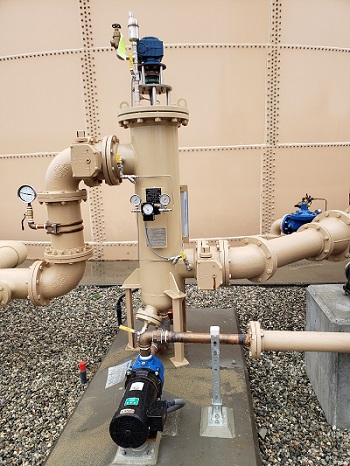Chemical processors rely heavily on membrane filtration technology to ensure consistent water quality, raw material recovery, and recycling when manufacturing acids, alkalis, fertilizers, inks, paints, coatings, soap, detergents, toiletries, perfumes, explosives, glues, and essential oils.
The industry also uses membrane filtration to desalinate, diafilter, and purify dyes, pigments, and optical brighteners; concentrate and dehydrate minerals; clarify caustic agents; produce polymers and recuperate metals. In additional, valuable raw materials in process water such as silica, paints, dyes, inks, catalysts, surfactants, and precious metals can be recovered prior to reuse or disposal.
The challenge is that membrane systems are delicate and can be easily damaged by large particulates in the water. A pre-filtration step eliminates this risk by removing oversized suspended solids to prevent damage, eliminate unnecessary maintenance, and reduce the cost of premature membrane replacement.
Among the pre-filtering options available, automatic self-cleaning scraper strainers are increasingly popular because they are affordable, require very minimal maintenance or attention, and can remove solids down to 75 microns. The strainers allow for continuous, uninterrupted flows even during blowdown cycles. When compared to filters that must be manually cleaned or even conventional backwash systems, automatic scraper strainers can save substantial costs on maintenance and membrane replacement.

Industrial water treatment and membrane systems
Although various filtration methods use membranes, the most mature is pressure driven membrane filtration, which relies on a liquid being forced through a filter membrane with a large surface area. Depending on the size and type of the particles involved, the process could be categorized as reverse osmosis, nanofiltration, ultrafiltration, or microfiltration.
In general, reverse osmosis is used to produce potable water or deionized water. Nanofiltration is used in wastewater treatment as well as by the petrochemical industry to purify gas condensates, and the chemical industry for solvent recovery. Ultrafiltration and microfiltration are increasingly used in water and wastewater treatments.
In industrial applications, water treatment is also vital to protect downstream equipment from fouling, scaling, corrosion, and other forms of damage or premature wear due to contaminants present in the source water. For these reasons, cooling tower and boiler feed water are generally pre-treated.
Membrane filtration is also utilised to treat non-potable water sources such as gray water and reclaimed/recycled “purple pipe” water.
Because the membranes are made using thin, porous sheets of material, failing to sufficiently pre-filter any large, suspended particles from the water can cause severe damage and fouling – leading to premature replacement and unnecessary maintenance, according to Robert Presser, Vice President of Acme Engineering Prod., Inc., a North American manufacturer of industrial self-cleaning strainers.
“Most membrane filter manufacturers recommend that all influents be pre-screened from 100 to 500 microns to maintain membrane filter efficiency,” says Presser, whose company is an ISO 9001:2015 certified manufacturer of environmental controls and systems with integrated mechanical, electrical and electronic capabilities.
He adds that automatic scraper strainers are typically installed before the intake plenum of membrane filters, after the supply pumps.

Extending membrane life
As an alternative to sand filters, centrifugal separators, and basket type strainers, automatic scraper strainers provide superior membrane protection while drastically reducing required maintenance.
Automatic scraper strainers like those from Acme Engineering can provide continuous removal of suspended solids to comprehensively protect membrane systems. The automatic units are motorized and designed to continually remove suspended particulates in industrial process water and wastewater to the specific size required down to .003 inches (75 microns).
Conventional manual strainers can become clogged quickly due to limitations in straining area. When that occurs, cleaning or media replacement is required, which increases maintenance costs. The other alternative for fine straining is automated backwash-style strainers of various designs. As particle sizes grow larger, however, large contaminants can jam up the backwash system or remain in the body of the strainer, requiring manual removal and interruption of the process flow.
With the automatic scraper strainer, cleaning is accomplished by a spring-loaded blade and brush system, managed by a fully automatic control system. Four scraper brushes rotate at 8 RPM, resulting in a cleaning rate of 32 strokes per minute. The scraper brushes get into the wedge-wire slots and dislodge resistant particulates and solids. This approach enables the scraper strainers to resist clogging and fouling when faced with large solids and high solids concentration. It ensures a complete cleaning and is very effective against even organic matter “biofouling.”
With this type of system, manual maintenance for cleaning is eliminated. Blowdown occurs only at the end of the intermittent scraping cycle when a valve is opened for a few seconds to remove solids from the collector area. Liquid loss is well below 1% of total flow.
With so much to gain, chemical processing managers should consider selecting an automated, self-cleaning system that is essentially “set-and-forget,” where automatic scraper strainers comprehensively protect delicate membranes and allow personnel to focus on other aspects of the facility.
For more info, visit Acme Engineering Prod. Inc. at acmeprod.com.














